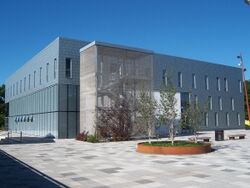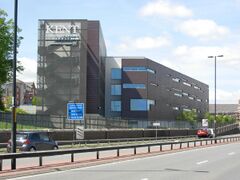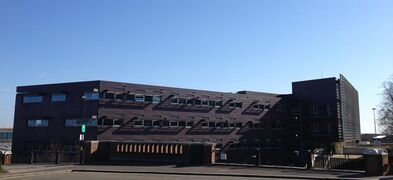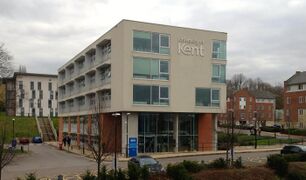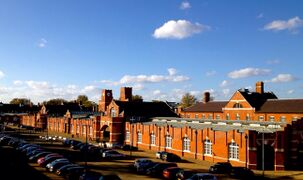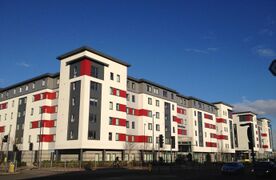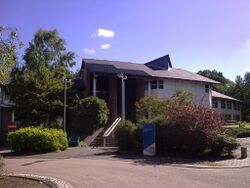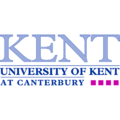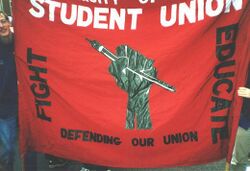University of Kent
Topic: Organization
 From HandWiki - Reading time: 26 min
From HandWiki - Reading time: 26 min
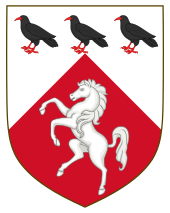 Coat of Arms University of Kent | |||||||||||||||||||||||||
Former name | University of Kent at Canterbury | ||||||||||||||||||||||||
|---|---|---|---|---|---|---|---|---|---|---|---|---|---|---|---|---|---|---|---|---|---|---|---|---|---|
| Motto | Latin: Cui servire regnare est | ||||||||||||||||||||||||
Motto in English | Literal translation: 'Whom to serve is to reign' (Book of Common Prayer translation: 'whose service is perfect freedom')[1] | ||||||||||||||||||||||||
| Type | Public | ||||||||||||||||||||||||
| Established | 4 January 1965 | ||||||||||||||||||||||||
| Endowment | £3.8 million (2022)[2] | ||||||||||||||||||||||||
| Budget | £260.4 million (2021–22)[2] | ||||||||||||||||||||||||
| Chancellor | Gavin Esler[3] | ||||||||||||||||||||||||
| Vice-Chancellor | Karen Cox[4] | ||||||||||||||||||||||||
| Visitor | The Archbishop of Canterbury ex officio | ||||||||||||||||||||||||
| Students | 19,265 (2018/19)[5] | ||||||||||||||||||||||||
| Undergraduates | 15,550 (2018/19)[5] | ||||||||||||||||||||||||
| Postgraduates | 3,715 (2018/19)[5] | ||||||||||||||||||||||||
| Location | |||||||||||||||||||||||||
| Campus | Semi-rural | ||||||||||||||||||||||||
| Kent Blue and Kent Red | Kent Blue and Kent Red | ||||||||||||||||||||||||
| Affiliations | Universities UK SGroup European Universities' Network EUA ACU Eastern ARC Universities at Medway | ||||||||||||||||||||||||
| Website | kent | ||||||||||||||||||||||||
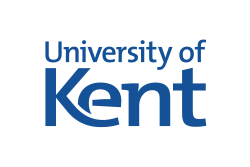 | |||||||||||||||||||||||||
The University of Kent (formerly the University of Kent at Canterbury, abbreviated as UKC) is a semi-collegiate public research university based in Kent, United Kingdom . The university was granted its royal charter on 4 January 1965 and the following year Princess Marina, Duchess of Kent, was formally installed as the first Chancellor.[6]
The university has its main campus north of Canterbury situated within 300 acres (120 hectares) of parkland, housing over 6,000 students, as well as a campus in Medway in Kent and European postgraduate centres in Brussels, Athens, Rome and Paris.[7] The university is international, with students from 158 different nationalities and 41% of its academic and research staff being from outside the United Kingdom.[8] It is a member of the Santander Network of European universities encouraging social and economic development.[9]
History
Origins
A university in the city of Canterbury was first considered in 1947, when an anticipated growth in student numbers led several residents to seek the creation of a new university, including Kent. However, the plans never came to fruition.[10] A decade later both population growth and greater demand for university places led to a re-consideration. In 1959 the Education Committee of Kent County Council explored the creation of a new university,[11] formally accepting the proposal unanimously on 24 February 1960.[12] Two months later the Education Committee agreed to seek a site at or near Canterbury, given the historical associations of the city, subject to the support of Canterbury City Council.[13]
By 1962 a site was found at Beverley Farm, straddling the then boundary between the City of Canterbury and the administrative county of Kent.[14] The university's original name, chosen in 1962, was the University of Kent at Canterbury, reflecting the fact that the campus straddled the boundary between the county borough of Canterbury and Kent County Council.[11] At the time it was the normal practice for universities to be named after the town or city whose boundaries they were in, with both "University of Kent" and "University of Canterbury" initially proposed. The name adopted reflected the support of both the city and county authorities; as well as the existence of the University of Canterbury in New Zealand, which officially opposed the use of a name too similar to its own.[15] The abbreviation "UKC" became a popular abbreviation for the university.[16]
1965 to 2000
The University of Kent at Canterbury was granted its Royal Charter on 4 January 1965 and the first group of 500 students arrived on 11 October 1965. [17]
On 30 March 1966 Princess Marina, Duchess of Kent was formally installed as the first Chancellor.[6]
The university was envisaged as being a collegiate establishment, with most students living in one of the colleges on campus, and as specialising in inter-disciplinary studies in all fields.[18] Over the years, changes in government policy and other changing demands have largely destroyed this original concept, leading to the present state, which is nearer the norm for a British university. However, the four original colleges – Darwin, Eliot, Keynes and Rutherford – remain, together with the newer Woolf and Turing colleges.[19]
The university grew at a rapid rate throughout the 1960s, with three colleges and many other buildings on campus being completed by the end of the decade.[20] The 1970s saw further construction, but the university also encountered the biggest physical problem in its history.[21] The university had been built above a tunnel on the disused Canterbury and Whitstable Railway. In July 1974 the tunnel collapsed, damaging part of the Cornwallis Building, which sank nearly a metre within about an hour on the evening of 11 July.[22] Fortunately, the university had insurance against subsidence, so it was able to pay for the south-west corner of the building to be demolished and replaced by a new wing at the other end of the building.[23]
Unix computers arrived in 1976 and UKC set up the first Unix to Unix copy (UUCP) test service to Bell Labs in the U.S. in 1979. UKC provided the first UUCO connections to non-academic users in the UK in the early 1980s.[24][25][26]
In 1982 the university opened the University Centre at Tonbridge (now the University of Kent at Tonbridge) for its School of Continuing education, helping to enhance the availability of teaching across the county.[27] Building elsewhere included the Park Wood accommodation village and the Darwin houses in 1989.
During the 1990s and 2000s the university expanded beyond its original campus, establishing campuses in Medway, Tonbridge and Brussels, and partnerships with Canterbury College, West Kent College, South Kent College and MidKent College.[27]
2000 to present
In the 2000s the university entered a collaboration named Universities at Medway with the University of Greenwich, MidKent College and Canterbury Christ Church University to deliver university provision in the Medway area.[28] This led to the development of the University of Kent at Medway, opened from 2001. Initially based at Mid-Kent College, a new joint campus opened in 2004.[28] Small postgraduate centres opened in Paris in 2009, and later in Rome and Athens.
As a consequence of the expansion outside Canterbury the university's name was formally changed to the University of Kent on 1 April 2003.[28] Part of the original reasoning for the name disappeared when local government reforms in the 1970s resulted in the Canterbury campus falling entirely within the City of Canterbury, which no longer has county borough status, and Kent County Council.
In 2007 the university was rebranded with a new logo and website. The logo was chosen following consultation with existing university students and those in sixth forms across the country.[29]
The University of Kent set its tuition fees for UK and European Union undergraduates at £9,000 for new entrants in 2012, which was approved by the Office for Fair Access (OFFA). The fee was approved by Council on 1 April 2011 and was confirmed by OFFA in July 2011. The proposed changes to UK and EU undergraduate tuition fees did not apply to international student fees.
Following the extension of Keynes College in 2001, two new colleges opened on the Canterbury campus, Woolf College for postgraduates in 2008 and Turing College for undergraduates in 2015. Several other new buildings were also added, including the Jarman School of Arts Building in 2009, the Colyer-Fergusson Music Building, a performing arts space, in 2012, and the Sibson building, housing maths and the business school, in 2017. A major £27m project to extend and refurbish the Templeman Library began in 2013, was completed in 2017 and formally opened in 2018.[30] Additional accommodation was provided for students at the Medway Campus with the completion of Liberty Quays in 2009.[31]
In 2015, the university held a number of events to celebrate its 50th anniversary. Festivals were held in Canterbury and Medway, a summer festival, the funding of twelve Beacon Projects and the temporary erection of a Ferris Wheel on the Canterbury campus.[32] In 2016, a consultation was launched on a masterplan for future development of the Canterbury campus.[33] In March 2017 it was announced that, in partnership with Canterbury Christ Church University, the University of Kent had been given funding to develop Kent and Medway Medical School.[34] In 2023, more than 450 students in the Kent's Student Union voted in favour of moving all catering to plant-based. The vote follows similar votes at other universities.[35]
Campuses
Canterbury campus
The main Canterbury campus covers 300 acres (120 hectares) and is situated in parkland in an elevated position just over two miles (three kilometres) from the city centre, with views over the city and Canterbury Cathedral UNESCO world heritage site. The campus currently has approximately 12,000 full-time and 6,200 part-time students, with accommodation for over 5000, in addition to 600 academic and research staff. Residential and academic buildings are intermingled in the central part of the campus, science building are clustered west of Giles Lens and there is a dedicated student village on the western edge, several minutes’ walk from the main campus. The campus is ecologically diverse and home to a number of protected species, including Great Crested Newts. The North West of the site is heavily forested, including pockets of ancient woodland, while the Southern Slopes contain a mix of wildflower and hay meadows, and there are seven ponds spread across the campus.
Facilities
The campus has a selection of shops, including a grocery store, bookshop, pharmacy and launderettes. Food and drink is provided by range of cafes and bars run either by the university or the student union. Bars include K-bar, in Keynes College, Mungo's, in Eliot College, Origins, in Darwin College, and Woody's in the Park Wood Student Village. Cafeteria style food is available in Rutherford College, fine dining at the Beagle Restaurant in Darwin College, and food is served at the bars and other cafes around campus.
The campus nightclub, The Venue, was refurbished and modernised in 2010 and is open Wednesday to Saturday. The upstairs area was originally used a live music venue, known as The Lighthouse and then the Attic, but has since been replaced with the Student Media Centre which hosts Inquire, KTV and CSR. Club nights and live music are also held at various bars on campus.
Sporting facilities are spread across two main sites: the sports centre, which contains several multi-purpose sports halls, a fitness suite, squash courts and climbing wall, and the Sports Pavilion site, with a variety of indoor and outdoor sports pitches and training facilities, including 3G and astroturf.
Gulbenkian arts complex
The Gulbenkian arts complex includes a theatre and cinema, as well as a small stage which hosts monthly comedy nights as well as occasional shows such as Jazz at Five and The Chortle Student Comedy Awards. The adjacent Colyer-Fergusson Building, which opened in 2013, includes an adaptable format concert/rehearsal hall with retractable seating and variable acoustics and practice rooms. The Gulbenkian Theatre seats 340 and presents student, professional and amateur shows throughout the year. The theatre was opened in 1969 and was named after the Calouste Gulbenkian Foundation which helped fund its construction. The Gulbenkian Cinema is an independent cinema in the Gulbenkian complex open to students and the general public. It is Kent's regional film theatre showing new mainstream and non-mainstream releases as well as archive and foreign language films. In the daytime the cinema is used as a lecture theatre for University students.[36] The Gulbenkian complex also hosts a cafe/ bar and restaurant facility open to students, staff and the general public.
Transport and access
The campus is accessed by road from either the West, with two entrances on the A290 Whitstable Road, or the East, via St Stephen's Hill. An off-road foot and cycle route connects the central campus to the Northern edge of the city, and a regular bus services (‘UniBus’) is also in operation, although with a more limited service outside of term time. The A2 dual carriageway links the campus and city to London, the port at Dover and the national motorway network. The campus also lies at the southern end of the Crab and Winkle Way, a 7-mile off-road foot and cycle path running through farm and woodland to the coastal fishing town of Whitstable, providing a link for cycle commuters.
The closest railway station to the campus is Canterbury West which is, as of 2009, served by Southeastern services to London St Pancras. These services stop at Ashford International en route, thus providing a direct connection to Eurostar services to France and Belgium. Southeastern services also connect Canterbury West and Canterbury East stations with London Victoria and Charing Cross. Both of the Canterbury stations can be accessed by the UniBus service. The nearest international air services are provided from the London airports, Gatwick and Heathrow, with indirect National Express coach services to both from Canterbury Bus Station with one transfer at London Victoria Coach Station. The campus is also served by two coach services (Route 007) to/from London each day, with further services operating from Canterbury bus station.
Medway campus
In 2000 the university joined with other educational institutes to form the "Universities for Medway" initiative, aimed at increasing participation in higher education in the Medway Towns.[28] The following year the University of Kent at Medway formally opened, initially based at Mid-Kent College.[28] By 2004 a new campus for the university had been established in the old Chatham Dockyard,[28] sharing a campus with Canterbury Christchurch University and University of Greenwich.
The University of Kent and Medway Park Leisure Centre have gone into a partnership to provide leisure facilities for university students and the general public. Medway Park (formerly the Black Lion Leisure Centre) was re-opened in 2011 by Princess Anne for use as a training venue for the 2012 London Olympics, as well as a training venue for the Egyptian and Congo National teams.
The campus accommodation, called Pier Quays, formerly named Liberty Quays until 2019 when Unite Group acquired Liberty Living,[37][38] was finished in late 2009, and caters for over 600 students. The accommodation building includes a Tesco Express, Subway, and Domino's Pizza, and Cargo, a bar showing sports, live music, and entertainment.
Tonbridge campus
In 1982 the university established the School of continuing education in the centre of Tonbridge, extending its coverage to the entire county of Kent.[39] Many buildings were added in the 1980s and 1990s.[27] The campus is now called the University of Kent at Tonbridge. It collaborates with the Kent Business School and Kent Innovation and Enterprise.
Organisation and administration
Faculties, departments and schools
Until 2020, the university was divided into three faculties, humanities, sciences and social sciences, which are further sub-divided into 20 schools:
|
|
|
The original plan was to have no academic sub-divisions within the three faculties (initially Humanities, Social Sciences and Natural Sciences) and to incorporate an interdisciplinary element to all degrees through common first year courses ("Part I") in each faculty, followed by specialist study in the second and final years ("Part II").[18] The lack of Departments encouraged the development of courses that crossed traditional divides, such as Chemical Physics, Chemistry with Control Engineering, Biological Chemistry and Environmental Physical Science.[40]
However, the interdisciplinary approach proved increasingly complex for two reasons. The levels of specialisation at A Levels meant that many students had not studied particular subjects for some years and this made it impossible to devise a course that both covered areas unstudied by some and did not bore others. This proved an especial problem in Natural Sciences, where many Mathematics students had not studied Chemistry at A Level and vice versa.
Additionally many subjects, particularly those in the Social Sciences, were not taught at A Level and required the first year as a grounding in the subject rather than an introduction to several different new subjects. Problems were especially encountered in the Faculty of Natural Sciences where the differing demands of Mathematics and physical sciences led to two almost completely separate programmes and student bases.[40] In 1970 this led to the creation of the School of Mathematical Studies, standing outside the Faculties.[41] The addition of other subjects led to increased pressure on common Part I programmes and increasingly students took more specialised Part I courses designed to prepare them for Part II study.[40]
Substantial change to this structure did not come until the 1990s, driven more by national government policy than curricular demands, which were, after all, very flexible by nature. In 1989 the Universities Funding Council, which was merged into the Higher Education Funding Council for England (HEFCE) in 1992, was charged by the UK Government to determine the cost for teaching each subject. To meet these accountancy requirements, Kent required for the first time that each member of staff declare a single discipline they would be affiliated with in future. When departments were formed in the early 1990s this led to a great deal of reorganisation of staff, and destroyed many existing inter-disciplinary relationships. Following the formation of departments, finance was devolved to departments based on how many students were taught. This quickly evolved into undermining the interdisciplinary context further, as departments sought to control finance by increasing the amount of specialist teaching in the first year.
The university now has the Faculties further divided into 18 Departments and Schools, ranging from the School of English to the Department of Biosciences, and from the Kent Law School to the Department of Economics. Also of note is the university's Brussels School of International Studies, located in Brussels, Belgium. The school offers master's degrees in international relations theory and international conflict analysis, along with an LLM in international law. In 2005 a new department, the Kent School of Architecture, began teaching its first students. In 2008, Wye College came under Kent's remit, in joint partnership with Imperial College London.
In 2020, because of financial pressures caused by a combination of the 2000 demographic dip and the 2020/21 COVID-19 pandemic, the university abolished the faculties and reorganised itself into 6 divisions (see below).
|
|
|
|
|
|
|---|
Colleges
The university is divided into eight colleges, six colleges named after distinguished scholars, one college after a town and one named after a student village. Colleges have academic schools, lecture theatres, seminar rooms and halls of residence. Each college has a Master, who is responsible for student welfare within their college. In chronological order of construction they are:
| Name | Foundation | Named after |
|---|---|---|
| Eliot College | 1965 | T. S. Eliot |
| Rutherford College | 1966 | Ernest Rutherford |
| Keynes College | 1968 | John Maynard Keynes |
| Darwin College | 1970 | Charles Darwin |
| Park Wood College | 1989 (Became a college in 2022) | Park Wood |
| Medway College | 2000 | Medway |
| Woolf College | 2008 | Virginia Woolf |
| Turing College | 2014 | Alan Turing |
The university also has an associate college named Chaucer College.
There was much discussion about the names adopted for most of the colleges with the following alternative names all in consideration at one point or another: for Eliot: Caxton, after William Caxton; for Keynes: Richborough, a town in Kent; Anselm, a former archbishop of Canterbury; and for Darwin: Anselm (again); Attlee, after Clement Attlee, the post-war Prime Minister; Becket, after Thomas Becket, another former archbishop (this was the recommendation of the college's provisional committee but rejected by the Senate); Conrad; Elgar, after Edward Elgar; Maitland; Marlowe, after Christopher Marlowe; Russell, after Bertrand Russell (this was the recommendation of the Senate but rejected by the council); Tyler, after both Wat Tyler and Tyler Hill on which the campus stands. The name for the college proved especially contentious and was eventually decided by a postal ballot of members of the Senate, choosing from: Attlee, Conrad, Darwin, Elgar, Maitland, Marlowe and Tyler.[42] (Both Becket and Tyler were eventually used as the names for residential buildings on campuses and the building housing both the Architecture and Anthropology departments is named Marlowe.)
Each college has residential rooms, lecture theatres, study rooms, computer rooms and social areas. The intention of the colleges was that they should not be just Halls of residence, but complete academic communities. Each college (except Woolf) has its own bar, all rebuilt on a larger scale, and originally its own dining hall (only Rutherford still has a functioning dining hall; Darwin's is hired out for conferences and events; Keynes's was closed in 2000 and converted into academic space, but in 2011 Dolche Vita was expanded and became the dining hall for Keynes students in catered accommodation after Keynes's expansion in 2011; and Eliot's was closed in 2006). It was expected that each college (more were planned) would have around 600 students as members, with an equivalent proportion of staff, with half the students living within the college itself and the rest coming onto campus to eat and study within their colleges. Many facilities, ranging from accommodation, tutorials and alumni relations, would be handled on a college basis. With no planned academic divisions below the Faculty level, the colleges would be main focus of students' lives and there would be no units of a similar or smaller size to provide a rival focus of loyalties.
This vision of a collegiate university has increasingly fallen away. The funding for colleges did not keep pace with the growth in student numbers, with the result that only four colleges were built. In later years when there was heavy student demand for scarce accommodation in Canterbury the solution was found in building additional on-campus accommodation but not in the form of further colleges. The hopes that students living off campus would stay around to eat dinner in their colleges were not met, whilst the abolition of college amenities fees removed students' direct stake in their colleges. With the growth of specialist subject departments as well as of other university wide facilities, more and more of the role of colleges was transferred to the central university. Accommodation and catering were transferred to the centralised University of Kent at Canterbury Hospitality (UKCH).[43]
Today the university does not operate as a traditional collegiate university – applications are made to the university as a whole, and many of the colleges rely on each other for day-to-day operation. Academic departments have no formal ties to colleges other than those that are located within particular college buildings due to availability of space, with lectures, seminars and tutorials taking place wherever there is an available room rather than on a college basis. Many students are allocated accommodation in their respective college, but some are housed in developments with no defined collegiate link whilst others are housed in different colleges.
Despite this the six College Student Committees, volunteer groups made up of elected officers and supporting volunteers, have retained a reasonably strong presence on campus. They run fundraising events and welfare campaigns throughout the academic year, and organise student events for their colleges during Welcome Week. Every student in the university retains a college affiliation to either Keynes, Eliot, Rutherford, Darwin or Park Wood even if they do not live in college accommodation. Students are encouraged to stay engaged with their College Committees throughout their time at the university.
Finances
In the financial year ended 31 July 2013, the University of Kent had a total income (including share of joint ventures) of £201.3 million, grew by 5.8% with an additional £21.4 million of fee income (2011/12 – £190.2 million) and total expenditure of £188.7 million (2011/12 – £175.9 million).[44] Key sources of income included £98.5 million from tuition fees and education contracts (2011/12 – £77.2 million), £48.9 million from Funding Council grants (2011/12 – £62.5 million), £13.4 million from research grants and contracts (2011/12 – £11.4 million) and £1.2 million from endowment and investment income (2011/12 – £1.09 million).[44] During the 2012/13 financial year the University of Kent had a capital expenditure of £28.2 million (2011/12 – £16.1 million).[44]
At year end the University of Kent had endowment assets of £6.3 million (2011/12 – £6.04 million) and total net assets of £175.9 million (2011/12 – £165.1 million).[44]
The annual income of the institution for 2021–22 was £260.4 million of which £17.7 million was from research grants and contracts, with an expenditure of £326.7 million.
Coat of arms and logo
The University of Kent's coat of arms was granted by the College of Arms in September 1967.[11] The white horse of Kent is taken from the arms of the County of Kent (and can also be seen on the Flag of Kent). The three Cornish choughs, originally belonging to the arms of Thomas Becket, were taken from the arms of the City of Canterbury. The Crest depicts the West Gate of Canterbury with a symbolic flow of water, presumably the Great Stour, below it. Two golden Bishops' Crosiers in the shape of a St. Andrews Cross are shown in front of it. The supporters – lions with the sterns of golden ships – are taken from the arms of the Cinque Ports.[45]
The Coat of Arms is now formally used only for degree certificates, degree programmes and some merchandise, as a result of the university seeking a consistent identity branding.[29]
Academic profile
Research
Kent is a research-led university with 24 schools and 40 specialist research centres spanning the sciences, technology, medical studies, the social sciences, arts and humanities.[46] In the 2021 Research Excellence Framework (REF), which assesses the quality of research in UK higher education institutions, Kent is ranked 38th by GPA and 32nd for research power (the grade point average score of a university, multiplied by the full-time equivalent number of researchers submitted).[47] In the 2014 REF, the University of Kent was ranked 40th out of 128 participating institutions in a 'grade point average' league table in The Times Higher Education Supplement (falling from 31st in 2008),[48] 30th in terms of 'Research Power' (rising from 40th in 2008),[48] and 19th in terms of 'Research Intensity' (rising from 49th in 2008).[49] The university had a total research income of £17.7 million in the 2021-22 academic year.[2]
Rankings
| National rankings | |
|---|---|
| Complete (2021)[50] | 48 |
| Guardian (2021)[51] | 56 |
| Times / Sunday Times (2021)[52] | 52 |
| Global rankings | |
| ARWU (2020)[53] | 401–500 |
| QS (2021)[54] | 336= |
| THE (2021)[55] | 401–500 |
| British Government assessment | |
| Teaching Excellence Framework[56] | Gold |
For 2020, The Guardian newspaper ranked Kent 65th in the UK, while The Sunday Times Good University Guide 2018 put Kent in 25th place, as did The Independent's Complete University Guide. QS placed Kent 46th in the UK and 366th in the world, while Times Higher Education placed it 44th in the UK and in the 301–350 group worldwide. In The Sunday Times 10-year (1998–2007) average ranking of British universities based on consistent league table performance, Kent was ranked 48th overall in the UK.[57] In 2015, Kent ranked ahead of 10 Russell Group universities according to the ranking of The Complete University Guide. In research, both The Guardian and The Times newspapers ranked Kent 29th, with The Independent rating the university 28th for its overall research activity in 2014.[58]
The National Student Survey in 2017 placed Kent joint 20th in the UK, with an overall satisfaction of 90%.[59]
In the Times Higher Education's assessment of the 2021 Research Excellence Framework, the History department at Kent was ranked first in the country.[60]
Library
The Templeman Library (named after Geoffrey Templeman, the university's first Vice-Chancellor) contains over a million items in stock including books, journals, videos, DVDs, and archive materials (for example, a full text of The Times from 1785 onwards), yet it is still only half its planned size. It has a materials fund of approximately £1million a year, and adds 12,000 items every year. It is open every day in term time, on a 24/7 basis. It receives 800,000 visits a year, with approximately half a million loans per annum.
The library also houses the British Cartoon Archive,[61] (established 1975[41]) a national collection of, mainly, newspaper cartoons, with over 90,000 images catalogued.
In 2013 work began to extend, refurbish and completely modernise the Templeman Library, including the addition of study space, along with the creation of a new purpose-built lecture theatre. Additionally, the Library facade underwent major renovation. This work was completed in 2017, with additional refurbishment work planned for 2018.
Franco-British programme
The bilingual Franco-British double-degree programme combines subjects in one degree and is taught in two countries. The first year is spent at the Institut d'études politiques de Lille (IEP), the second and third years at the University of Kent, the fourth year at the IEP of Lille and the fifth is spent in Canterbury, Brussels or Lille.
The students of the Franco-British double-degree programme receive, at the end of the fourth year, the Bachelor of Arts (BA) degree from the University of Kent, the Diplôme by the IEP of Lille and, at the end of the fifth year, either the Master of Arts (MA) degree in Canterbury or in Brussels or the Master delivered by the IEP of Lille, chosen between 14 parcours de formation by the IEP of Lille.[62][63]
Student life
Admissions and enrolment
|
The student population is mixed, with around 15,000 undergraduates and 4,000 postgraduates, with approximately 22% of students coming from overseas.[67] Approximately 128 different nationalities are currently represented, and the female to male ratio is 55 women to every 45 men.[67]
New students entering the university in 2021 had an average of 127 points (the equivalent of BBB-ABB at A Level).[66] According to the 2023 Times and Sunday Times Good University Guide, approximately 4% of Kent's undergraduates come from independent schools.[68]
Students' Union
The Students' Union, officially known as "Kent Union", is the student representative body for students at the university. It is led by five elected full-time officers (the 'sabbatical team'), a Board of trustees, part-time student officers and 'lay' members of the local community and business selected for their specialist expertise.
The university has two Co-Op shops, one in the main campus area, and the other in Park Wood student village. The two all-purpose food and essentials stores were previously known Essentials and Parkwood Essentials. The Union also operates the Park Wood bar Woody's and a 1,500 capacity nightclub The Venue which, unusually, is located on the central campus. Essentials, the Venue and other shops and Union offices are located in purpose-made buildings completed in 1998.[69] Kent Union also co-ordinates over 200 sports clubs and societies, as well as media outlets, volunteering and charity activities, and provides student welfare services.
The Students' Union has hosted concerts by bands including Led Zeppelin[70] and The Who.[71]
Demonstrations
In early March 1970 a General Meeting of the University of Kent at Canterbury Students' Union voted to occupy the Cornwallis Building as part of a national student movement to open personal records to individual student scrutiny.[72] The occupation lasted about two weeks, with a majority vote ending the occupation on 18 March. Approximately 400 students marched out of the Cornwallis Building to present a set of demands that were handed by Union President David Lawrence to the University Registrar Mr Eric Fox. The demands had been drawn up and debated by groups of up to 300 students at a time in meetings and seminars held throughout the occupation.[73]
In the early to mid-1970s, along with other plate-glass universities, the Union had a reputation for revolutionary politics, leading to demands for law changes from some staff trade unionists.[74] It was active in anti-poll tax, anti-student loans and anti-racism campaigns as well as safety campaigns on campus in the late 1980s.
In 2003, ahead of the 'Top Up Fees' vote, the Union took 300 students to take part in the NUS UK Student Demonstrations on three double decker buses. The Union covered all the transport costs to the demonstration. In 2010, ahead of a parliamentary vote on issues concerning raising tuition fees, the Union took part in the national demonstrations. The union heavily subsidised the transport for 500 students to get to London.
Chaplaincy
Whilst the university is secular, there is a chaplaincy consisting of permanent Anglican and Catholic priests and a Pentecostal minister, as well as part-time chaplains from other denominations and faiths. The chaplaincy runs the annual Carol Service that takes place every year in Canterbury Cathedral at the end of Autumn Term.
Student housing
In addition to the student housing in the colleges, the university also has the following student housing:
- Darwin Houses, a set of 26 student houses next to Darwin College, opened in 1989[39]
- Becket Court, next to Eliot College, opened in 1990[69]
- Tyler Court, three blocks of halls of residence. Block A was opened in 1995[69] mostly for postgraduates; Blocks B and C were completed in 2004[75] for undergraduates.
- Parkwood, a mini student village comprising 262 two-storey houses and a recently built apartment complex, about 10 minutes walk from the main campus. The initial houses were opened in 1980.[39] A large addition to the Parkwood area was completed in 2005, comprising a number of en-suite fitted rooms grouped into four, five and six bedroom flats.
- Turing College was officially opened in September 2015; 9 buildings of 3 to 4 floors each.[76]
Student media
CSR 97.4FM
University of Kent and Canterbury Christ Church University, as well as their associated Students' Unions, fund Canterbury's only student and community radio station: CSR 97.4FM. The radio station broadcasts from studios at both universities 24 hours a day, with live broadcasting from 7 am – 12 am. CSR 97.4FM replaced UKC Radio, the original student-run radio station at the university.
InQuire
The university has a student newspaper named InQuire and an online news website InQuire Media[77] (launched in January 2008). The newspaper is published every month and is made in its entirety by a group of student volunteers. Content is edited by volunteers and is focused on campus issues and news that affects students. Funded by Kent Union, the newspaper is subject to moderation before publication.
Kent Television
Kent Television (KTV), founded in 2012, is the volunteer-run television studio at the university.[78]
Notable alumni
- Alumni of the University of Kent include several academics (particularly at British universities), two recipients of the Nobel Prize in Literature, a recipient of the Victoria Cross and relations of the extended British royal family.
See also
- Armorial of UK universities
- List of universities in the United Kingdom
- Plate glass university
References
- ↑ Graham Martin, From Vision to Reality: the Making of the University of Kent at Canterbury (University of Kent at Canterbury, 1990) page 36 ISBN:978-0-904938-03-6 As Martin notes "Our former Information Officer has ventured the opinion that Cranmer would not have got very high marks had this phrase appeared in an O-Level Latin paper!"
- ↑ 2.0 2.1 2.2 "Financial Statements for the Year to 31 July 2022". University of Kent. p. 18. https://www.kent.ac.uk/finance/about/accounts/Financial%20Statements%20-%202022.pdf.
- ↑ "BBC man Gavin Esler is Kent University's new chancellor". BBC News. BBC News. 25 January 2014. https://www.bbc.co.uk/news/uk-england-kent-25895016.
- ↑ "Vice-Chancellor – About Kent". Kent.ac.uk. 1 August 2017. https://www.kent.ac.uk/ovc/vc/.
- ↑ 5.0 5.1 5.2 "Where do HE students study?". Higher Education Statistics Agency. https://www.hesa.ac.uk/data-and-analysis/students/where-study. Retrieved 1 March 2020.
- ↑ 6.0 6.1 Graham Martin, From Vision to Reality: the Making of the University of Kent at Canterbury (University of Kent at Canterbury, 1990) pages 11–36 ISBN:978-0-904938-03-6
- ↑ "Where can I study?". http://www.kent.ac.uk/locations/.
- ↑ "University of Kent" (in en-US). https://www.timeshighereducation.com/world-university-rankings/university-kent#ranking-dataset/128777.
- ↑ "Santander". http://www.sgroup.be/glowna.html.
- ↑ Graham Martin, From Vision to Reality: the Making of the University of Kent at Canterbury (University of Kent at Canterbury, 1990) page 14 ISBN:978-0-904938-03-6
- ↑ 11.0 11.1 11.2 "About Kent – History – 1959–1969". University of Kent. 11 January 2007. http://www.kent.ac.uk/about/history/history59.html.
- ↑ "Step Towards Kent University". The Times. 25 February 1960.
- ↑ "Siting of a Kent University – Canterbury Area Recommended". The Times. 26 April 1960.
- ↑ "Site of University For Kent". The Times. 1 February 1962.
- ↑ "Second University Sponsor Resigns". The Times. 17 October 1962.
- ↑ Graham Martin, From Vision to Reality: the Making of the University of Kent at Canterbury (University of Kent at Canterbury, 1990) pages 29–30 ISBN:978-0-904938-03-6
- ↑ "The University of Kent at Canterbury", The Guardian (Manchester), October 11, 1965, p. 6 ("The first 500 undergraduate students arrive today at the new University of Kent at Canterbury")
- ↑ 18.0 18.1 "University of Kent Sets Out To Be Different – Emphasis on Collegiate-Based Life". The Times. 4 April 1963.
- ↑ "College Masters". University of Kent. https://www.kent.ac.uk/about/past-officers/masters.html.
- ↑ "Kent Life" in Kent: The Magazine for The University of Kent Spring 2005 No. 44 page 4
- ↑ Graham Martin, From Vision to Reality: the Making of the University of Kent at Canterbury (University of Kent at Canterbury, 1990) pages 225–231 ISBN:978-0-904938-03-6
- ↑ Graham Martin, From Vision to Reality: the Making of the University of Kent at Canterbury (University of Kent at Canterbury, 1990) page 228 ISBN:978-0-904938-03-6
- ↑ Graham Martin, From Vision to Reality: the Making of the University of Kent at Canterbury (University of Kent at Canterbury, 1990) page 231 ISBN:978-0-904938-03-6
- ↑ Houlder, Peter (January 19, 2007). "Starting the Commercial Internet in the UK". https://www.uknof.org.uk/uknof6/Houlder-History.pdf.
- ↑ Reid, Jim (April 3, 2007). "Networking in UK Academia ~25 Years Ago". https://www.uknof.org.uk/uknof7/Reid-History.pdf.
- ↑ "BBC Internet Services – History". https://support.bbc.co.uk/support/history.html.
- ↑ 27.0 27.1 27.2 "Kent Life" in Kent: The Magazine for The University of Kent Spring 2005 No. 44 page 5
- ↑ 28.0 28.1 28.2 28.3 28.4 28.5 "About Kent – History – 2000–2006". University of Kent. 11 January 2007. http://www.kent.ac.uk/about/history/history00.html.
- ↑ 29.0 29.1 "Our visual identity (pdf)". University of Kent. 14 March 2007. http://www.kent.ac.uk/cdo/publications/corporate/UoK_Interim_Section_Guidelines.pdf.
- ↑ Herrema, Martin. "£27m Templeman library refurbishment nears completion". https://www.kent.ac.uk/news/kentlife/15050/27m-templeman-library-refurbishment-nears-completion.
- ↑ "Pride in our past". University of Kent. https://www.kent.ac.uk/50/pride-in-our-past/index.html.
- ↑ "50th Anniversary Highlights". University of Kent. https://www.kent.ac.uk/50/highlights/index.html.
- ↑ "Master Plan Consultation". University of Kent. https://www.kent.ac.uk/masterplan/.
- ↑ "Universities receive funding to develop Kent and Medway's first medical school". University of Kent. https://www.kent.ac.uk/news/kentlife/17394/universities-receive-funding-to-develop-kent-and-medways-first-medical-school.
- ↑ Fuller, Christian (2023-06-27). "University of Kent students vote for plant-based catering" (in en-GB). https://www.bbc.com/news/articles/cg3npd4xvwjo.
- ↑ "What's on – Gulbenkian". Kent.ac.uk. http://www.kent.ac.uk/gulbenkian/.
- ↑ Media, Insider. "Unite Group completes Liberty Living acquisition". https://www.insidermedia.com/news/south-west/unite-group-completes-liberty-living-acquisition.
- ↑ "Medway student accommodation at Pier Quays | Unite Students". https://www.unitestudents.com/medway/pier-quays.
- ↑ 39.0 39.1 39.2 "About Kent – History – 1980–1989". University of Kent. 11 January 2007. http://www.kent.ac.uk/about/history/history80.html.
- ↑ 40.0 40.1 40.2 Graham Martin, From Vision to Reality: the Making of the University of Kent at Canterbury (University of Kent at Canterbury, 1990) pages 39–54 ISBN:978-0-904938-03-6
- ↑ 41.0 41.1 "About Kent – History – 1970–1979". University of Kent. 11 January 2007. http://www.kent.ac.uk/about/history/history70.html.
- ↑ Graham Martin, From Vision to Reality: the Making of the University of Kent at Canterbury (University of Kent at Canterbury, 1990) pages 122–126 ISBN:978-0-904938-03-6
- ↑ Graham Martin, From Vision to Reality: the Making of the University of Kent at Canterbury (University of Kent at Canterbury, 1990) ISBN:978-0-904938-03-6
- ↑ 44.0 44.1 44.2 44.3 "Financial Statements 2013". University of Kent. http://www.kent.ac.uk/finance/about/accounts/accounts20122013.pdf.
- ↑ Graham Martin, From Vision to Reality: the Making of the University of Kent at Canterbury (University of Kent at Canterbury, 1990) pages 33–36 ISBN:978-0-904938-03-6
- ↑ "University of Kent". http://www.topuniversities.com/universities/university-kent.
- ↑ "REF 2021: Quality ratings hit new high in expanded assessment". Times Higher Education. 12 May 2022. https://www.timeshighereducation.com/news/ref-2021-research-excellence-framework-results-announced.
- ↑ 48.0 48.1 "REF 2014 results: table of excellence". Times Higher Education. 18 December 2014. https://www.timeshighereducation.com/news/ref-2014-results-table-of-excellence/2017590.article.
- ↑ "REF 2014: winners and losers in 'intensity' ranking". Times Higher Education. 19 December 2014. https://www.timeshighereducation.com/news/ref-2014-winners-and-losers-in-intensity-ranking/2017633.article.
- ↑ "University League Table 2021". The Complete University Guide. 1 June 2020. http://www.thecompleteuniversityguide.co.uk/league-tables/rankings.
- ↑ "University league tables 2021". The Guardian. 5 September 2020. https://www.theguardian.com/education/ng-interactive/2020/sep/05/the-best-uk-universities-2021-league-table.
- ↑ "The Times and Sunday Times University Good University Guide 2021". Times Newspapers. http://nuk-tnl-editorial-prod-staticassets.s3.amazonaws.com/2016/bespoke/university-guide/index.html.
- ↑ "Academic Ranking of World Universities 2020". Shanghai Ranking Consultancy. http://www.shanghairanking.com/ARWU2020.html.
- ↑ "QS World University Rankings 2021". Quacquarelli Symonds Ltd.. https://www.topuniversities.com/university-rankings/world-university-rankings/2021.
- ↑ "World University Rankings 2021". Times Higher Education. https://www.timeshighereducation.com/world-university-rankings/2021/world-ranking#!/page/0/length/-1/sort_by/rank/sort_order/asc/cols/stats.
- ↑ "Teaching Excellence Framework outcomes". Higher Education Funding Council for England. https://www.officeforstudents.org.uk/advice-and-guidance/teaching/tef-outcomes/.
- ↑ "University ranking based on performance over 10 years". The Times (London). 2007. http://extras.timesonline.co.uk/pdfs/univ07ten.pdf.
- ↑ "Key Kent facts". https://www.kent.ac.uk/about/keyfacts2018.html.
- ↑ "National Student Survey 2016: overall satisfaction results". Times Higher Education. 10 August 2016. https://www.timeshighereducation.com/student/news/national-student-survey-2016-overall-satisfaction-results.
- ↑ "REF 2021: History" (in en). 2022-05-12. https://www.timeshighereducation.com/news/ref-2021-history.
- ↑ "British Cartoon Archive website". Library.kent.ac.uk. http://library.kent.ac.uk/cartoons/.
- ↑ "14 parcours de formation". 195.83.2.11. http://195.83.2.11/SCOLA/maquette/parcours_en.html.
- ↑ Official Site of the Franco-British course at the IEP of Lille and at the University of Kent at Canterbury – French and English
- ↑ 64.0 64.1 "UCAS Undergraduate Sector-Level End of Cycle Data Resources 2022". UCAS. December 2022. Show me... Domicile by Provider. https://www.ucas.com/data-and-analysis/undergraduate-statistics-and-reports/ucas-undergraduate-sector-level-end-cycle-data-resources-2022.
- ↑ "2022 entry UCAS Undergraduate reports by sex, area background, and ethnic group". UCAS. 2 February 2023. https://www.ucas.com/data-and-analysis/undergraduate-statistics-and-reports/ucas-undergraduate-sector-level-end-cycle-data-resources-2022/2022-entry-ucas-undergraduate-reports-sex-area-background-and-ethnic-group.
- ↑ 66.0 66.1 "University League Tables entry standards 2024". The Complete University Guide. https://www.thecompleteuniversityguide.co.uk/league-tables/rankings?tabletype=full-table&sortby=entry-standards.
- ↑ 67.0 67.1 "Table 0a – All students by institution, mode of study, level of study, gender and domicile 2005/06". Higher Education Statistics Agency online statistics. http://www.hesa.ac.uk/index.php/component/option,com_datatables/task,show_file/defs,0/Itemid,121/catdex,3/disp,institution0506.htm/dld,institution0506.xls/yrStr,2005+to+2006/dfile,studefs0506.htm/area,institution/mx,0/. There are approximately 18,00 students. 15,270 are United Kingdom students (3,385 postgraduates and 11,885 undergraduates), a total of 83.8%. 10,095 students are female (2165 postgraduates and 7390 undergraduates), a total of 55.4%.
- ↑ "The Times and Sunday Times Good University Guide 2023". The Good University Guide (London). http://extras.thetimes.co.uk/gooduniversityguide/institutions/.(Subscription content?)
- ↑ 69.0 69.1 69.2 "About Kent – History – 1990–1999". University of Kent. 11 January 2007. http://www.kent.ac.uk/about/history/history90.html.
- ↑ "University of Kent". Led Zeppelin – Official Website. http://www.ledzeppelin.com/venue/university-kent.
- ↑ "Year 1970". The Who Concert Guide. http://www.thewholive.de/konzerte/zeige_konzert.php?GroupID=1&Jahr=1970.
- ↑ a Staff Reporter (8 March 1970). "Students sit in at four universities". The Guardian: p. 3.
- ↑ Staff Reporters (19 March 1970). "Kent students end sit-in with no demand met". The Guardian: p. 6.
- ↑ "Trade unionists want law to curb student militants". The Times. 2 February 1974.
- ↑ "About Kent – History – 2000–2006". University of Kent. 11 January 2007. http://www.kent.ac.uk/about/history/history90.html.
- ↑ "Turing College at University of Kent named after famous Second World War codebreaker Alan Turing". 30 November 2015. http://www.kentonline.co.uk/canterbury/news/university-college-named-after-codebreaker-47166/.
- ↑ "InQuire Media". InQuire Media. 5 June 2019. http://www.inquirelive.co.uk.
- ↑ "KTV – Kent Union Website". Kent Union. http://www.kentunion.co.uk/organisation/13182/.
External links
[ ⚑ ] 51°17′49″N 1°04′08″E / 51.297°N 1.069°E
 |
 KSF
KSF